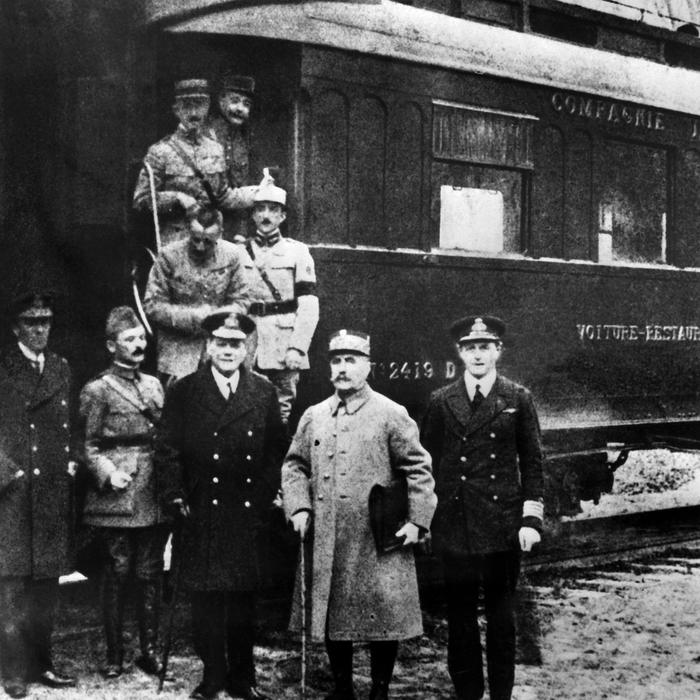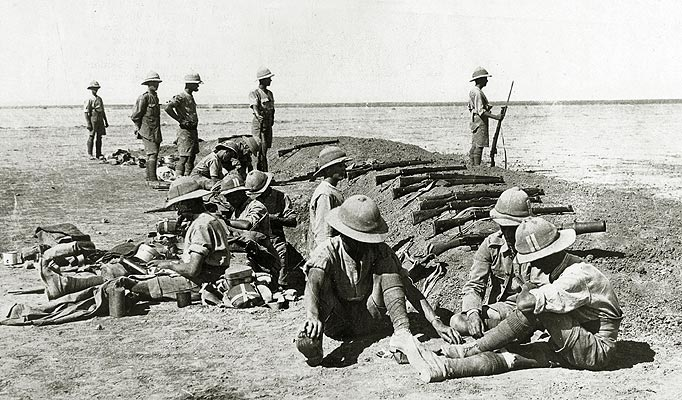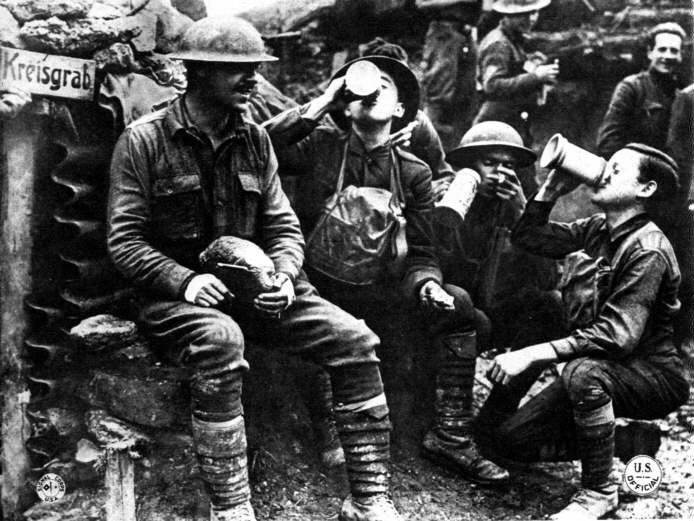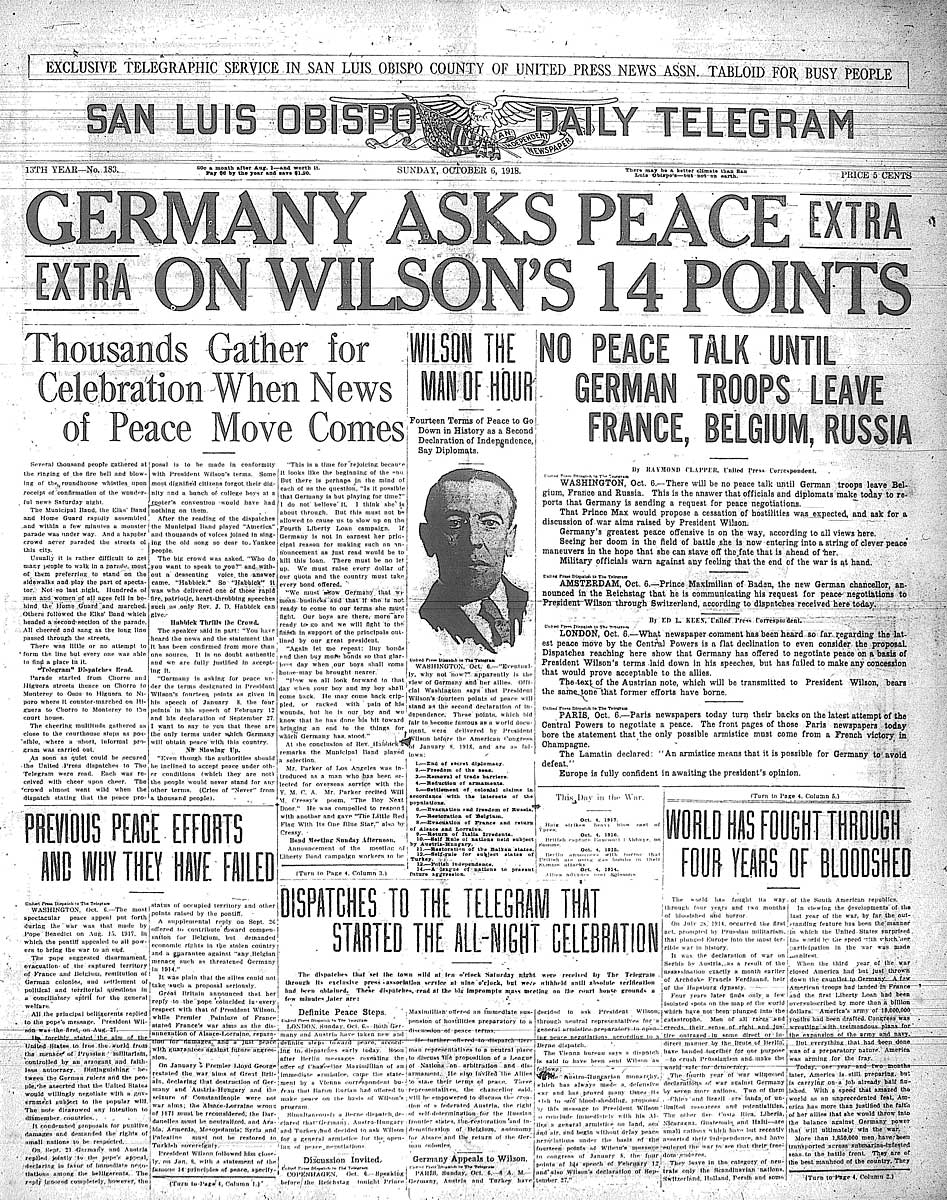Dead Bodies Everywhere.
Among the Allies: Colored Rockets, Singing and Cheering.
Bolsheviks See Revolution Spreading.
(7 November) On the Western Front a century ago, the armistice is now underway, and at the same time the fighting goes on.
So observes historian Martin Gilbert. “The armistice talks with Germany would go on. So would the fighting, even as the German and Austrian armies were in retreat and areas that had been under German control for four years were being liberated.

Armistice talks begin, Marshall Foch center, second from right.
“The signing of the armistice” reports Gilbert, “first ended the war in Mesopotamia (Iraq and Syria).” This brings the British army all the way to the southern edge of Turkey and the Turkish heartland.
That armistice brings about the demobilization of the Turkish army, Gilbert reports, the release of all prisoners of war, and the evacuation of all Arab lands then occupied by the Turkish army.
The terms of that armistice do not provide for the protection of the Armenian community in Turkey, which was treated so viciously during the war under the control of the Turkish army.

Preliminary to Middle East peace, October 1918.
Back on the Western Front, “for the first time,” reports Gilbert, “the enemy lines were completely penetrated, Pershing commented. ”Completely penetrated.”
“The Germans fled.”
One American soldier describes the scene on November 1st on the Western Front battle field. “The roads and fields were strewn with dead Germans, horses, masses of artillery, transport, guns and bayonets. By the end of the day it was clear the Germans would not be able to regroup or counter attack.”
On this same day in Berlin,
..agitation is growing to force the Kaiser to abdicate the throne. But he is having nothing of it.
“I wouldn’t dream of abandoning the throne,” the Kaiser says, “because of a few hundred Jews and a thousand workers.”
The Kaiser has already informed the United States that the German government was awaiting the armistice terms, according to historian Martin Gilbert.

Waiting for word of armistice on Western Front..
The Austrian armistice is signed on November 3rd but that does not bring stability in Vienna. Lenin and the Bolsheviks in Moscow believe this is only the first step in the spread of world-wide soviet style revolution.
Also on November 3rd reports Gilbert, “the Allies agreed to a formal German request for an armistice but the fighting there continued.”

Wilson talks of peace, but not of surrender.
In Italy, the Italian Front, all fighting ended there at three in the afternoon on November 4th. In one outpost “the sky was lit up with bonfires and the firing of colored rockets. Singing and cheering bells ringing in the distance. It was an hour of perfection and of accomplishment.”
But the fighting continues at the heart of the Western Front.

My grandfather was involved in the Austrian front while fighting with Americans and Britons, with Italian allies. After he arrived in France, many in his infantry division were sent on to join the British and Italian troops fighting Austria northeast of Venice. They were then called “Pershing’s Propaganda Army”, to show a united allied front. See a 2010 book about the 332nd Infantry Division, “American Lions” (a later nickname) by Robert and Rebecca Dallessandro. My grandfather returned to the US in May 1919, living until 1986, dying at age 95. (He also served as a Major in the South Pacific during WWII).
Below is a brief anecdote about repeated marching in a manner to make the Austrians believe more American soldiers were facing them across the Piave River (that my uncle confirmed having heard my grandfather talk about in mid-1900s). (Following is from 332nd WWI website, http://www.armyhistoryfnd.org/armyhist/armymain.html . Click on “Army Research”, then “WWI”, then “332nd Infantry in Italy” )
From 332nd official history of action in Oct-Nov 1918:
Within the first week, the men of the 332nd undertook a series of long marches in which no one was excused from participation. Each morning, the companies of the regiment separated, each pursuing a different course along the roads. Marches were made “in double file, not in squad formation, so that when the march began, the interval lengthening between men, each company appeared larger than it really was.” The companies maneuvered their way along the highways each day, all marching in different directions. A daily change in headgear was also ordered; one day overseas caps were worn, the next day campaign hats, while the third day saw every man wearing his steel helmet. Moreover, the men were ordered to change their dress from day to day; jerkins were worn one day, overcoats the next, raincoats the following day. All of this was done in sight of Austrian observers in attempt to convince the Austrians that large numbers of American troops were arriving to take their places along the Piave.
On 4 November, an armistice with Austria went into effect. The men of the regiment celebrated that at least their part of the war was over. Much to the amazement of Colonel Wallace and other American officers of the 332nd, the Austrian generals were convinced that there were at least six American divisions facing them in Italy, and possibly as many as 300,000 men total. When told that the American forces in Italy were comprised of one regiment, the Austrian officers refused to believe it. Colonel Wallace quickly realized that the ruse created by continuously marching his men down different roads, wearing different types of headgear and other equipment clearly worked. As a result of the 332nd’s deception, Austrian morale plummeted. Wallace’s deception may have shortened the war on the Italian front and saved countless lives.
My Great Uncle, Pvt Marcell B. Thiry fought in Company M, 3rd Battalion, 332nd Infantry Regiment and was there at the final battle of the Italian Front at dawn of the 4th of November at Ponte-della-Delizia. As Vanguard of the 10th Anglo-Italian Army under Lord Cavan, the Regiment continued forward towards Austria, the Armistice had given the Allies use of Austrian roads and rail lines for passage to Germany. They made it to Cormons in Austria by November 11th. The town was suffering an acute epidemic of the influenza, and my Great Uncle became infected, he was transported to the Field Hospital in Udine, Italy were he succumbed on November 15th. Also read, “In Italy With the 332nd Infantry” by SGM Joseph L. Lettau for a riveting firsthand account. This book has been scanned in and is available for free reading online; a printed version is also available.